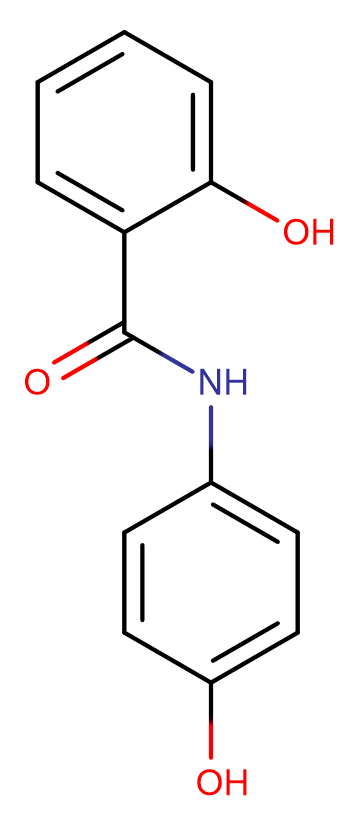
Osalmid
CAS No. 526-18-1
Osalmid( Osalmid | Auxobil | Oksafenamid | NSC 93960 | NSC-93960 | Salmidochol | PHPS | Saryuurin )
Catalog No. M14861 CAS No. 526-18-1
Osalmid is a choleretic drug.
Purity : >98% (HPLC)
 COA
COA
 Datasheet
Datasheet
 HNMR
HNMR
 HPLC
HPLC
 MSDS
MSDS
 Handing Instructions
Handing Instructions
| Size | Price / USD | Stock | Quantity |
| 50MG | 31 | In Stock |


|
| 100MG | 45 | In Stock |


|
| 200MG | 53 | In Stock |


|
| 500MG | 71 | In Stock |


|
| 1G | 87 | In Stock |


|
Biological Information
-
Product NameOsalmid
-
NoteResearch use only, not for human use.
-
Brief DescriptionOsalmid is a choleretic drug.
-
DescriptionOsalmid is a choleretic drug.(In Vitro):Osalmid is identified as a potential ribonucleotide reductase small subunit M2 (RRM2) compound. Osalmid is 10-fold more active in inhibiting ribonucleotide reductase (RR) activity than hydroxyurea, and significantly inhibits HBV DNA and cccDNA synthesis in HepG2.2.15 cells in a time- and dose-dependent manner. After treatment for 8 days with Osalmid, the EC50 for HBV DNA inhibition are 11.1 μM for culture supernatant and 16.5 μM for cells. Osalmid suppresses RR activity in a concentration-dependent manner, with an IC50 of 8.23 μM. Osalmid is shown to possess potent activity against a 3TC-resistant HBV strain, suggesting utility in treating drug-resistant HBV infections.(In Vivo):Osalmid reduces RR activity and HBV replication in HBV-transgenic mice and shows a synergistic efficacy with 3TC without significant toxicity. Oral dosing of osalmid at 400 mg/kg/d results in a time-dependent inhibition of HBV DNA replication. After treatment for 4 weeks, osalmid suppresses HBV DNA replication by about 40-45% as compared to the control in mouse sera and liver tissues.
-
In VitroOsalmid is identified as a potential ribonucleotide reductase small subunit M2 (RRM2) compound. Osalmid is 10-fold more active in inhibiting ribonucleotide reductase (RR) activity than hydroxyurea, and significantly inhibits HBV DNA and cccDNA synthesis in HepG2.2.15 cells in a time- and dose-dependent manner. After treatment for 8 days with Osalmid, the EC50 for HBV DNA inhibition are 11.1 μM for culture supernatant and 16.5 μM for cells. Osalmid suppresses RR activity in a concentration-dependent manner, with an IC50 of 8.23 μM. Osalmid is shown to possess potent activity against a 3TC-resistant HBV strain, suggesting utility in treating drug-resistant HBV infections.
-
In VivoOsalmid reduces RR activity and HBV replication in HBV-transgenic mice and shows a synergistic efficacy with 3TC without significant toxicity. Oral dosing of osalmid at 400 mg/kg/d results in a time-dependent inhibition of HBV DNA replication. After treatment for 4 weeks, osalmid suppresses HBV DNA replication by about 40-45% as compared to the control in mouse sera and liver tissues.
-
SynonymsOsalmid | Auxobil | Oksafenamid | NSC 93960 | NSC-93960 | Salmidochol | PHPS | Saryuurin
-
PathwayCell Cycle/DNA Damage
-
TargetDNA/RNA Synthesis
-
RecptorRR
-
Research AreaInflammation/Immunology
-
Indication——
Chemical Information
-
CAS Number526-18-1
-
Formula Weight229.23
-
Molecular FormulaC13H11NO3
-
Purity>98% (HPLC)
-
SolubilitySoluble in Ethanol, DMSO
-
SMILESO=C(NC1=CC=C(O)C=C1)C2=CC=CC=C2O
-
Chemical Name2-hydroxy-N-(4-hydroxyphenyl)benzamide
Shipping & Storage Information
-
Storage(-20℃)
-
ShippingWith Ice Pack
-
Stability≥ 2 years
Reference
1.Sadanaga T, et al. J Chromatogr. 1981 Apr 10;223(1):243-6.
molnova catalog



related products
-
MM41
MM41 is a human telomeric and gene promoter DNA quadruplex stabilizer with an IC50 of <10 nM against the MIA PaCa-2 pancreatic cancer cell line.
-
JH-RE-06
JH-RE-06 disrupts mutagenic translesion synthesis (TLS) by preventing the recruitment of mutagenic POLζ. JH-RE-06 is an effective REV1-REV7 interface inhibitor (IC50=0.78 μM; Kd=0.42 μM), which targets REV1 that interacts with the REV7 subunit of POLζ. JH-RE-06 also improves chemotherapy.
-
Sodium Camptothecin
Sodium Camptothecin is a plant alkaloid, with antitumor activity. Sodium Camptothecin is a reversible inhibitor of RNA synthesis.



 Cart
Cart
 sales@molnova.com
sales@molnova.com


